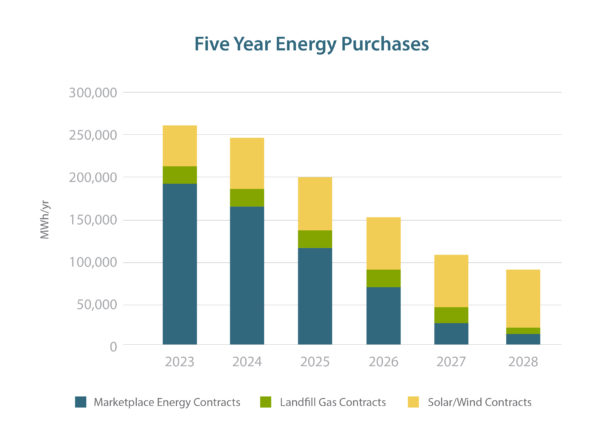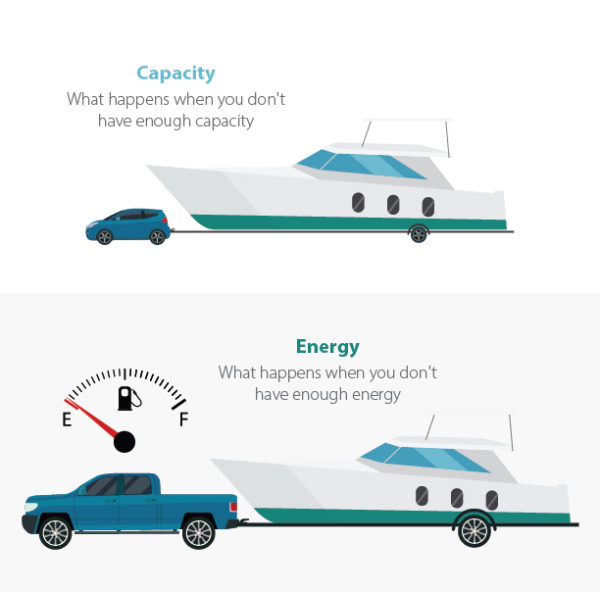The BLP approaches buying power in a similar way to how you might invest for retirement –purchasing in smaller volumes, from multiple sources, over regular intervals, varying terms and durations, and diversifying the purchase type to manage risk. This approach provides a more secure and stable future for controlling energy costs. Many factors impact the near and long-term energy markets. Fuel costs, wind, and solar production estimates, plant availabilities and forced outages, transmission congestion and constraints, load projections, weather forecasts, and fluctuations in economic activity are just a few such factors. To protect the utility and its customers from these fluctuations in market forces, the BLP diversifies its energy purchases, as you would your retirement investments.

The BLP partners with other municipal utilities in the state, through “joint action” with the Michigan Public Power Agency (MPPA), pooling resources and load to achieve economies of scale and scope. MPPA collaborates with the BLP by developing longer-term power supply plans to lessen wholesale price volatility, which translates into a more stable rate structure for customers. It takes careful planning, execution, and constant vigilance by all parties involved to effectively manage our power supply purchases and costs which protects customers from market volatility.
A Five-Year Outlook
Prior to the closure of the Sims Power Plant in February 2020, the BLP began to build a new power supply plan at MPPA, phasing in both energy and capacity purchases (see an explanation of the difference between energy and capacity later in the article), to replace the supply from Sims. The BLP continues that forward-looking approach and has laddered energy purchases in lowering volumes out to 2028. These purchases contain a mixture of short-term contracts and longer-term power purchase agreements for specific renewable power resources. While the graph here looks simple, the underlying data involves over 180 separate energy transactions!

Over the course of the past eight years this strategy has allowed the BLP to:
- Decrease retail rates multiple times.
- Invest in capacity and energy from two new wind power projects and five separate solar power projects.
- Increase the renewable energy portfolio from 9.4% in 2019 to 22% in 2022 and is projected to reach 28% by 2025.
The most recent addition to the renewable energy portfolio, the Calhoun Solar project, is a 200 MW solar farm that went online in Spring 2023. The municipal members of MPPA pooled their resources to take 50 MW’s of that project. Grand Haven’s entitlement share of the purchase is 5.85 MW, or approximately 12,000 MW-hrs per year, enough to supply approximately 1,700 homes.
Last year’s increases in solar prices due to labor and material shortages serve as a cautionary tale about “overinvesting” in any single source at any given time. Delays in solar projects left some utilities with an open energy position when the energy markets were experiencing extremely high prices. This is why the BLP diversifies power supply commitments and spreads its “eggs across many different baskets” to protect the community from wholesale price volatility.
If a utility chose to buy into a single contract, at a given time, for too long or too short a term, it may overcommit to a singular purchase that may later become “out of market,” or the utility could not “hedge” enough supply in advance, forcing it to buy more than it would otherwise in the real-time market. This could result in spending more money to make up for a potential shortfall when costs are higher. On the other hand, if a utility overlooks influencing factors related to the global landscape, it may miss opportunities to capitalize on a recovering supply chain, which could lower costs, or new legislation, which could open doors to advancing technologies, making renewable energy more feasible. These are all factors that drive a utility to diversify its power supply portfolio over multiple energy transactions.
What is the Difference Between Capacity and Energy?
When we discuss our power supply plans, the industry uses specific terms that may sound similar, like energy or capacity, however, it’s important to differentiate between them. Capacity can be defined as how much power is available at any given moment. Energy relates to how that power is consumed over time. Grand Haven BLP needs to make its buying decisions based upon both categories. Consider it this way:
Let’s say you just inherited a big boat, which you need to hitch to your car and drive to the lake. To move that boat, it requires a certain amount of horsepower to be able to tow the boat–that power can be viewed as Capacity. However, you only have a compact car, so you can imagine that no matter how eager you are to get to the lake, that car isn’t going to be able to meet the demand to pull that boat! You need more Capacity.

Taking the analogy further – let’s say you borrow your brother’s pickup truck, which has plenty of capacity to pull the boat. However, you neglect to fill the tank and run out of gas before you get to the lake. Regardless of your total Capacity, you didn’t have enough Energy. The fuel that you use to get to the lake represents the Energy. You need both, capacity and energy, to be successful in your outing. Careful planning around both is also true for a power purchasing strategy.
Much like laddering in our energy purchases, the BLP also ladders in capacity purchases and has capacity needs almost fully covered out to 2027, with other purchases extending long after that.
Reliability, Affordability, & Sustainability
In serving the Grand Haven community, the BLP, in partnership with MPPA, evaluates and balances multiple factors within the three pillars (reliability, affordability, and sustainability) as the touchpoint for guiding every decision. Whether it’s the long-term vs. short-term strategy, the phased investment in renewable energy, the management of energy and capacity supplies, or how best to adapt to the ever-changing marketplace, the BLP has the expertise and experience to handle that responsibility for the betterment of our community.


